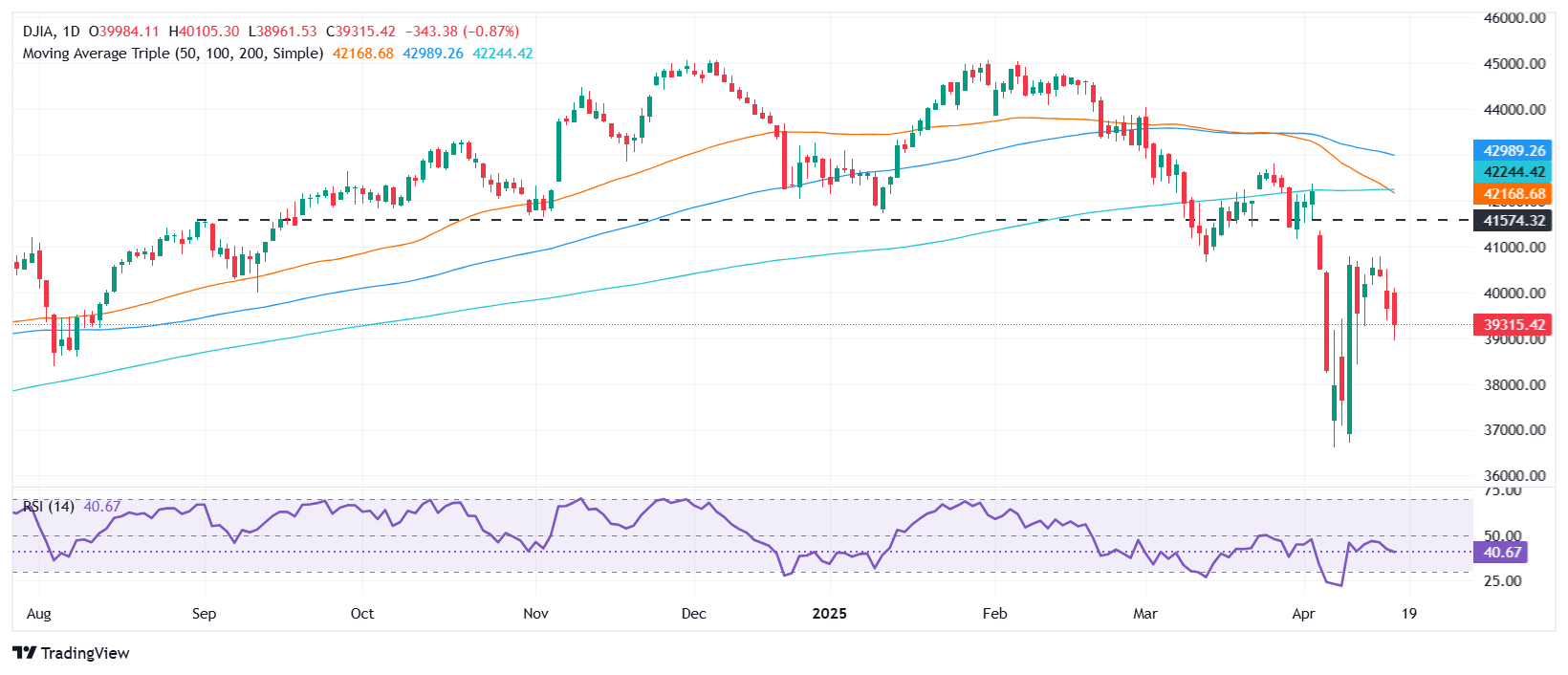Dow Jones crashes over 500 points as UnitedHealth tanks, Trump slams Powell for delayed cuts
- UnitedHealth plunges as much as 23% after slashing full-year guidance, dragging healthcare sector and Dow lower.
- Trump criticizes Powell’s hesitation, praises ECB rate cut, calls Fed “too late” as inflation fears persist.
- Powell flags difficulty in balancing mandates, fueling stagflation concerns; markets price just 9% chance of May cut.
The Dow Jones Industrial Average (DJIA) on Thursday plunged over 500 points, or over 1.30%, and UnitedHealth Group (UNH) shares nosedived 23% following an earnings miss and a pessimistic full-year outlook. The DJIA fell below the 39,500 mark, while US President Donald Trump's anger at Fed Chair Jerome Powell reignited following Powell's speech in Chicago.
DJIA drops below 39,500 after UNH earnings shock; Powell’s stagflation warning and Trump’s Fed critique shake sentiment
Trump commented that the Fed should have lowered rates as oil, groceries and egg prices are moving down. He praised the European Central Bank's (ECB) earlier decision to cut rates but added that the Fed is “too late” to ease policy.
On Wednesday, Fed Chair Powell adopted a cautious stance saying the focus is inflation. Nevertheless, he acknowledged that balancing dual mandates is becoming difficult, suggesting that a stagflationary scenario looms in which prices rise even though economic growth stalls.
Read more: UnitedHealth stock caves 22% as its cuts full-year guidance
The US jobs market remains solid following the Initial Jobless Claims report for April 12. Meanwhile, housing data was mixed, with Building Permits showing that plans for building houses increased, while Housing Starts showed that home construction is slowing down.
Meanwhile, President Trump said he is very confident about a trade deal with the European Union (EU) and China.
Meanwhile, recent data suggested that traders see a 9% chance of a Fed rate cut at the May meeting. Therefore, US equities remain subject to trade tensions and geopolitical shocks.
Dow Jones price forecast
The Dow Jones remains bearishly biased, with the index falling below the 39,000 mark for the first time in five trading days. Nevertheless, bulls remain stubborn and lifted the index above the 39,000 figure, which could pave the way for some consolidation within the 39,000–40,000 mark.
If bulls push the Dow above 39,984, this would turn the index positive and pave the way to test 40,000. A breach of the latter clears the path toward 40,500, followed by the next key resistance at the April 1 high at 40,909 and 41,000.
On the downside, a drop below 39,000 means traders will target the April 10 daily low of 38,431.

Dow Jones FAQs
The Dow Jones Industrial Average, one of the oldest stock market indices in the world, is compiled of the 30 most traded stocks in the US. The index is price-weighted rather than weighted by capitalization. It is calculated by summing the prices of the constituent stocks and dividing them by a factor, currently 0.152. The index was founded by Charles Dow, who also founded the Wall Street Journal. In later years it has been criticized for not being broadly representative enough because it only tracks 30 conglomerates, unlike broader indices such as the S&P 500.
Many different factors drive the Dow Jones Industrial Average (DJIA). The aggregate performance of the component companies revealed in quarterly company earnings reports is the main one. US and global macroeconomic data also contributes as it impacts on investor sentiment. The level of interest rates, set by the Federal Reserve (Fed), also influences the DJIA as it affects the cost of credit, on which many corporations are heavily reliant. Therefore, inflation can be a major driver as well as other metrics which impact the Fed decisions.
Dow Theory is a method for identifying the primary trend of the stock market developed by Charles Dow. A key step is to compare the direction of the Dow Jones Industrial Average (DJIA) and the Dow Jones Transportation Average (DJTA) and only follow trends where both are moving in the same direction. Volume is a confirmatory criteria. The theory uses elements of peak and trough analysis. Dow’s theory posits three trend phases: accumulation, when smart money starts buying or selling; public participation, when the wider public joins in; and distribution, when the smart money exits.
There are a number of ways to trade the DJIA. One is to use ETFs which allow investors to trade the DJIA as a single security, rather than having to buy shares in all 30 constituent companies. A leading example is the SPDR Dow Jones Industrial Average ETF (DIA). DJIA futures contracts enable traders to speculate on the future value of the index and Options provide the right, but not the obligation, to buy or sell the index at a predetermined price in the future. Mutual funds enable investors to buy a share of a diversified portfolio of DJIA stocks thus providing exposure to the overall index.
